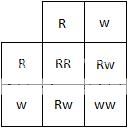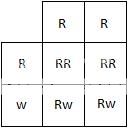But this blog is just to lay down the basics so you can understand my next blog about my virtual plant breeding project. If you already know how this stuff works, you might want to skip it. If you want to learn how plant breeding works, keep reading.
These are the basics. Let’s say I have a red-flowered plant that is true breeding. This means that if I breed this plant with itself the seed will produce red-flowered plants that are also true breeding. The same goes if I breed any of these plants together. I will always have red-flowered true breeding plants.
Let’s say I have a white-flowered plant that is true breeding. I know that if I breed it with itself, the seed will always give me white-flowered plants that are also true breeding.
Let’s now say I breed the red-flowered plant with the white-flowered plant. What will the seeds produce? The seeds will produce hybrids. This means that each child contains a red gene and a white gene. This is where the issue of dominance comes in. What colour are the flowers? Which gene wins?
We can say that a gene can be dominant or recessive. If the red gene is dominant then all the children would be red. In this case, the white gene is recessive. If all the children are white, then the white gene is dominant and the red gene is recessive.
Let’s say for this example that the red gene is dominant. So all the seeds from our hybrids produce red plants but hybrids are not true-breeding. So what happens when I breed two hybrids together?
There are three possibilities. A new plant could take one dominant gene from both parents, or it could take one dominant gene from one parent and one recessive gene from the other, or it could take a recessive gene from both parents. This is what punnet squares are for: to show the possible combinations without having to write a long awkward paragraph like this.

In a punnet square diagram you use letters to represent the genotypes. In this case, since my dominant genes are red, I’ve used an uppercase R to represent it, and a lowercase w to represent the recessive white genes. (Most people would write this using an uppercase R and a lowercase r but it’s more confusing that way.)
Along the top are the hybrid genes from one parent, along the left side are hybrid genes from the other parent. The middle 4 cells contain the possible combinations of genes from the two parents. As you can see there is RR, Rw, Rw and ww. RR is a plant with two dominant red genes. Rw is a hybrid with a dominant red gene and a recessive white gene. The ww is a plant with two recessive white genes. RR and WW are our true breeding plants. Rw is a hybrid.
So when we breed two hybrids together we get 25% RR plants, 25% ww plants and 50% hybrids. The larger the number of plants we have the more accurate these figures will be. You might breed two hybrids together and get all true-breeding red plants, but it’s not as likely with a larger sample size.
Homozygous means a gene is true breeding. Heterozygous means a gene is a hybrid. In this example, we'd call RR a homozygous dominant gene, ww is a homozygous recessive gene, and Rw a heterozygous gene.
Now. We know what happens if we breed our red-flowered true-breeding plant, the RR (homozygous dominant) with itself. We know what happens if we breed our white-flowered true-breeding plant, the ww (homozygous recessive) with itself. And now we know what happens when we breed two hybrids together, the Rw. So what happens when we breed a hybrid with a true-breeding plant?

If, as in the diagram, our true-breeding plant is homozygous dominant, RR, you get 50% RR and 50% Rw. So all our flowers are red, but only half of them are true-breeding. If we had used the homozygous recessive plant, ww, as the true-breeding plant, then we'd have 50% ww and 50% Rw. Half of them would be red, the other half white.
Now you know all the rules. The last couple of things to mention are these. Sometimes a dominant gene isn’t very dominant. Maybe this is down to self-esteem issues. Let’s say that our red/white hybrid’s dominant red gene isn’t very dominant at all. The resulting flower will come out pink. So, sometimes hybrids can be three colours instead of just two. This is very useful because it makes the true-breeding plants easy to identify.
Lastly, when you breed together two true-breeding plants to produce a hybrid, those hybrids are called F1. If you go to a garden store you’ll probably see on the packet that they are F1 seeds. They are hybrids. There’s such a thing called ‘hybrid vigour’ where F1 plants will be more ‘vigorous’ than the parents; the plants from F1 seeds will be stronger or faster or sexier. F2 seeds are seeds from an F1 generation. As we’ve seen when we breed together two hybrids, 50% of the children will be hybrids. So half of F2 seeds will be hybrids. This is why, when you keep seeds from the plants you grew from F1 seeds bought at a garden store, they don’t turn out looking much like the first generation of plants. You have a 1 in 2 chance of getting plants that have the same trait you're looking for.
I also learned about backcrossing and how to use it to maximise the number of true-breeding plants in a generation. This is useful when you have one awesome true-breeding plant and you need to produce more but the plant can’t breed with itself. Some plants won’t. Cannabis is one excellent example. Here is my backcrossing blog.
Now you know how plant breeding works, read my next blog to understand what I did with this stuff.





No comments:
Post a Comment